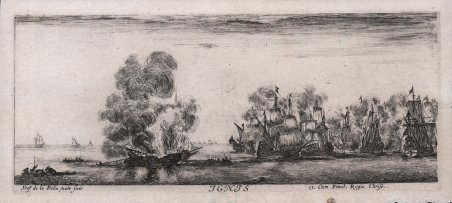Flotta di navi in fiamme; in mare, una nave al centro e una flotta di navi a destra, tutte avvolte dalle fiamme, con una barca a remi piena di persone in primo piano a sinistra. Dalla serie I quattro elementi. Acquaforte, 1648 circa, incisa nel margine sotto l'immagine con titolo e dettaglio della produzione: "Stef. de la Bella inventit" e con privilegio reale: "ex. Cum Privil. Regis Christ". Bella impressione su carta vergata coeva, con margini sottili, buono stato di conservazione. Stefano della Bella fu uno degli incisori più interessanti e originali nella Firenze del XVII secolo e può considerarsi l’unico geniale continuatore dell’opera di Jacques Callot. La sua educazione artistica ebbe inizio a Firenze nella bottega degli orafi Gasparo Mola e Orazio Vanni, e la precisione del segno, tipica dell’arte orafa resterà caratteristica del suo stile. Studiò poi presso Giovanni Battista Vanni e forse anche presso il Cantagallina e Cesare Dandini, ma ben presto si dedicò all'incisione. Il suo vero maestro può considerarsi Jacques Callot, l’incisore francese che soggiornò a lungo a Firenze lasciando una forte impronta nel panorama artistico della città. Gli anni più importanti della sua carriera sono quelli che trascorre a Parigi, dal 1639 al 1650, stipendiato da Lorenzo de' Medici: lavorò insieme ad Israel Silvestre, con gli editori Langlois, Ciartres e Pierre Mariette, per stampatori francesi e per commissioni di gran prestigio, come quelle del 1641 per il cardinale Richelieu che gli affidò le illustrazioni delle sue imprese guerresche. Intorno al 1647, durante un viaggio in Olanda, dove eseguì le acqueforti con le vedute del porto di Amsterdam, incontrò Rembrandt e da quella data notiamo una eco profonda dell’arte dell’olandese nella grafica del Della Bella. Bibliografia De Vesme - Massar Stefano della Bella (1971) n. 756, I/III. Fleet of ships on fire; in the sea, one ship at centre and a fleet of ships to right, all engulfed in flames, with a rowing boat full of people at front left. From the series of ' Four Elements. Etching, circa 1648, ettered in margin below image with title, production detail: "Stef. de la Bella invent fecit" and with royal privilege: "ex. Cum Privil. Regis Christ." A fine impression on contemporary laid paper, with thin margins, good condition. Massar is incorrect in stating that the series must predate 1647 as that was the year of death of the publisher Langlois, whose name appears on the third state. However, it was François Langlois who died in 1647, while the name is given on the prints as "NLanglois" in reference to Nicolas. As he was François's son there are no such constrictions of ' date for the production of the series. Stefano della Bella was one of the most interesting and original engravers in 17th-century Florence and can be considered the only brilliant continuator of Jacques Callot's work. His artistic education began in Florence in the workshop of the goldsmiths Gasparo Mola and Orazio Vanni, and the precision of sign, typical of the goldsmith's art, will remain characteristic of his style. He then studied under Giovanni Battista Vanni and perhaps also under Cantagallina and Cesare Dandini, but soon turned to engraving. His real master can be considered Jacques Callot, the French engraver who stayed in Florence for a long time and left a strong imprint on the city's artistic scene. The most important years of his career were the ones he spent in Paris, from 1639 to 1650, salaried by Lorenzo de' Medici: he worked together with Israel Silvestre, with the publishers Langlois, Ciartres and Pierre Mariette, for French printers and for commissions of great prestige, such as those of 1641 for Cardinal Richelieu, who entrusted him with illustrations of his warlike exploits. Around 1647, during a trip to Holland, where he executed etchings with views of the port of Amsterdam, he met Rembrandt, and from that date we note a profound echo of the Dutchman's art in Della Bella's graphic work. Bibliografia De Vesme - Massar Stefano della Bella (1971) n. 756, I/III. Cfr.

Find out how to use
Find out how to use

